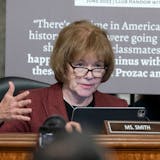Like many school bus drivers, Cat Briggs pads out her workweek by taking on extra assignments throughout the day. In addition to delivering kids from home to school and back again in Eagan, Briggs signs up to take them on field trips or haul them across town to attend special tutoring programs.
The habit, Briggs said, is borne of necessity. Work for hourly school employees like bus drivers and paraprofessionals dries up in the summer, which means they have to load up on hours during the school year to survive leaner times.
"Toward the end of the summer, I was kind of scrambling," Briggs said.
A new law tucked into the sweeping 2023 education bill provided relief for hourly workers like Briggs, allowing them to tap into unemployment insurance that pays half their regular hourly wage during the summer. Lawmakers set aside $135 million to pay for the benefit through 2025. But with economic headwinds on the horizon, the program's long-term viability may be in question.
Minnesota lawmakers are expecting a $2.4 billion surplus heading into the next legislative session, which state budget officials suggest saving in order to offset a potential deficit in 2025. The about-face in the state's financial projections is due in part to the ballooning cost of another new program mandated by the education bill: free school meals that will cost $80 million more than legislators forecast this year.
More kids are eating lunch at school than state officials had projected. School board members and district administrators worry a similar story will play out with unemployment insurance.
"With a less-than-positive forecast, that can raise some questions about ongoing funding," said Kirk Schneidawind, executive director of the Minnesota School Boards Association. "Is the state going to make it a priority as we perhaps move into different budget circumstances than we had two years ago?"
Districts paid out about $40.5 million in unemployment benefits in 2023, according to the Minnesota Department of Education.


